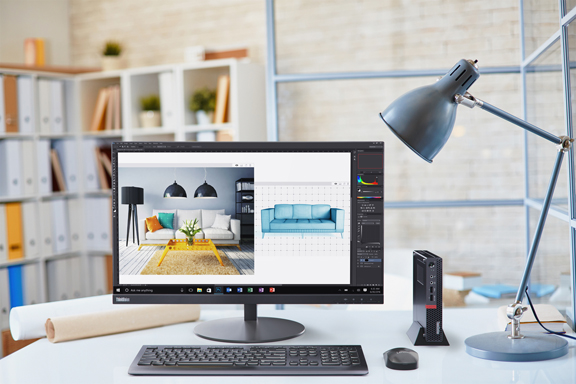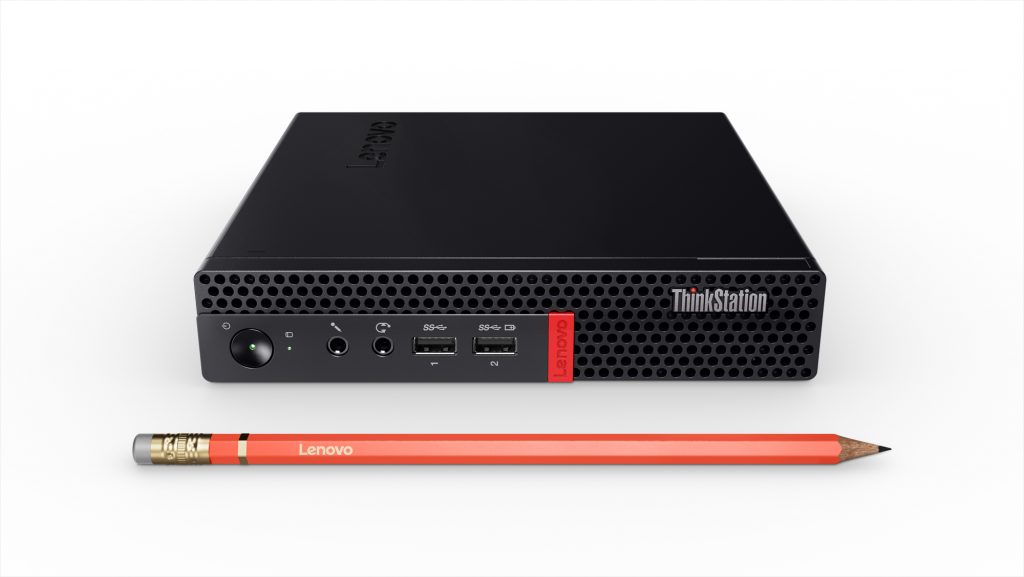
Lenovo introduces ThinkStation P320 Tiny, measuring only slightly larger than a DVD box (image courtesy of Lenovo).
Latest News
June 22, 2017
 Lenovo introduces ThinkStation P320 Tiny, measuring only slightly larger than a DVD box (image courtesy of Lenovo).
Lenovo introduces ThinkStation P320 Tiny, measuring only slightly larger than a DVD box (image courtesy of Lenovo).The incredibly small form factor of Lenovo’s latest workstation is a reflection of people’s changing attitude toward hardware.
Measuring only 1.4” x 7.1” x 7.2” (35mm x 179mm x 183mm), the ThinkStation P320 Tiny stands no taller than a chopstick. Its surface area is only slightly larger than a DVD box.
Previously, the workstation’s compute capacity is matched by its size—the more powerful the machine, the larger it is. But this is the era in which workstations must compete with mobile devices and tablets for the consumer’s limited investment dollars. The times seem to favor smaller, nimbler hardware specimens over Panza-like warhorses.
Blurring the Line Between Mobile and Desktop
With no built-in keyboard or monitor, the P320 Tiny needs to be deployed like a desktop tower, like its larger cousin P320. Yet, the 2.9LB box is so small and portable that it blurs the line between mobile and desktop. Road warriors will find that the P320 Tiny takes up less space in their luggage than, say, the mobile workstation ThinkPad P71 or the tablet ThinkPad P40 Yoga does.
“We want to be mindful of the changes we see around us. For instance, more people are working from home or remotely on smaller desks,” said Scott Ruppert, Lenovo’s workstation portfolio manager. “Companies are adopting different styles with shared spaces. Besides, more educational institutions with computer labs are popping up, but they don’t have the IT infrastructure or space to house large tower workstations.
The CPU inside is Intel Core i7 (up to 7th generation is supported). The NVIDIA Quadro P600 gives the small box robust graphics boost. The discrete graphics card makes a difference in the performance of graphics-intense 3D CAD software, rendering programs, and multi-threaded simulation applications.
Usually workstations run on Intel Xeon processors, the chip maker’s dedicated product line for professional hardware.
“In this chassis, with the thermal envelop we had to work with, we needed to go with a low wattage option. So the P320 Tiny only comes with Intel Core i. If you really need a Xeon-powered machine, you can choose one of the bigger tower workstations,” said Ruppert.
 Resting horizontally, the ThinkStation P320 Tiny is of the same length as a pencil (image courtesy of Lenovo).
Resting horizontally, the ThinkStation P320 Tiny is of the same length as a pencil (image courtesy of Lenovo).In the Shadow of VDI and Cloud
Traditional desktop workstations face tremendous competition from the emerging VDI (virtual desktop infrastructure) market, which encourages professional to work with sufficiently powerful virtual machines remotely, using lightweight, mobile devices for access. Some of the professional engineering, design, and simulation software titles once available only for desktop installation are now moving to the cloud. The shift also gives a portion of the professional workforce the option to work with consumer-class hardware rather than professional-grade workstations.
Starting at $849 in North America, the ThinkStation P320 Tiny is priced to compete with top-tier consumer hardware. Its form factor, compute power, and affordability also gives VDI users the option deploy the P320 Tiny as the access device.
“In our original plan, we didn’t developed the P320 Tiny as a response to the VDI market,” explained Ruppert. “But we’re finding that, because of its form factor, it lends itself very well to the VDI market.”
HP, a rival of Lenovo in the workstation market, launched the HP Mini Z2 at Autodesk University in the winter of 2016. HP wrote, “The stylish, new HP Z2 Mini Workstation delivers breakthrough power and versatility and at only 2.3” high is 90% smaller than a traditional business-class tower.”
Launching the P320 Tiny this week, Lenovo wrote, “At 96% smaller than a traditional workstation, the ThinkStation P320 Tiny is extremely compact. It’s also very versatile and can fit just about anywhere, horizontally or vertically —mount it on a wall, under a desk, or even behind a monitor to create a modular all-in-one.”
In the recent years, leading workstation makers introduced all-in-all PCs and mini-towers to deal with the encroachment of mobile tablets. The rise of affordably priced tiny and mini workstations is another sign that smaller hardware that pacts a punch is the path to larger market share.
Subscribe to our FREE magazine, FREE email newsletters or both!
Latest News
About the Author
Kenneth Wong is Digital Engineering’s resident blogger and senior editor. Email him at [email protected] or share your thoughts on this article at digitaleng.news/facebook.
Follow DE





